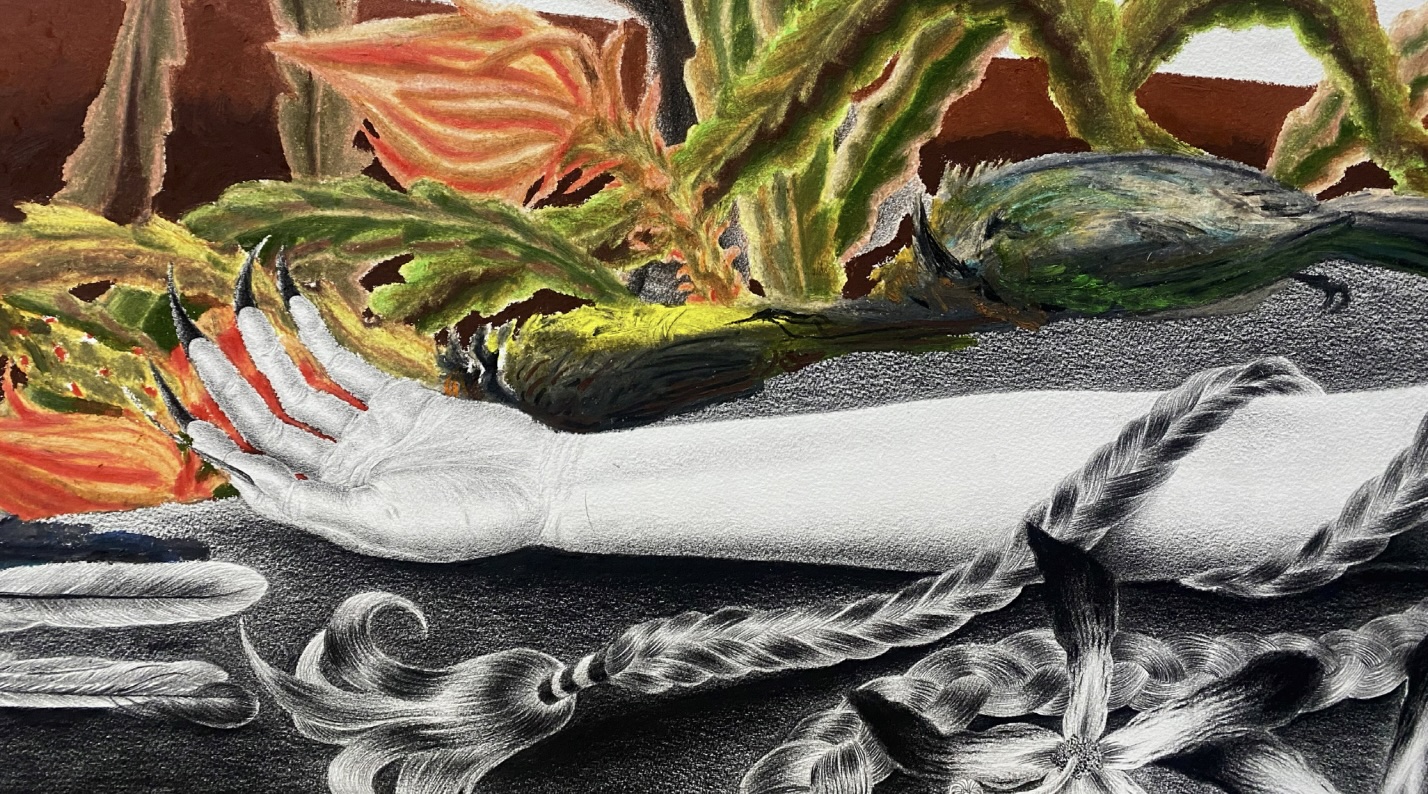
Ángela Ferrari
Necesité personas
Exhibition
-> Sep 4 2025 – Oct 30 2025
Ferrari defines her work as a “grotesque-passionate baroquism,” a world inhabited by intense scenes where the vegetal, the animal, and the human coexist in extreme tensions: grazes, bites, tears, fragilities. Her paintings and drawings evoke nineteenth-century hunting tapestries forgotten in decaying mansions, where each gesture—whether delicate or brutal—tests the line that separates hunter from prey. This gaze toward the blurred frontier between nature and culture, between impulse and representation, expands in Necesité personas into a collective terrain where Ferrari invites nine artists to dialogue through reactions and resonances.
The proposal arises from a context marked by migration and uprooting. Ferrari arrived in Mexico amid a social crisis in Argentina, and since then has conceived of her practice as a form of personal agency in the face of precarity and the closure of global and personal borders. This project also embodies a gesture of gratitude toward both Mexico and Argentina, an acknowledgment of the territories, affections, and imaginaries that have welcomed and transformed her. In the artist’s words: “I inhabit this world, and I never forget that it is a shared world; that is why inviting this exercise enriches it, enriches me. This approach is my way of generating, in company, other ways of relating through generosity, difference, and affection.”
Necesité personas thus unfolds around two modes of work: reaction—responding in consonance to another’s work—and resonance—assimilating, prolonging, and expanding an external gesture within one’s own creative process. In both cases, the encounter is central. The exhibition thereby sketches a space of interculturality where the common and the different recognize each other: an essay in community grounded in sensibility.
The materials chosen by each artist reinforce this will toward hybridity and dialogue. Imanol Castro’s ceramics intertwine with Luciana Lubreto’s experiments on paper; the anthropomorphic and vegetal graphite drawings of Florencia Rodríguez Giles and Samuel Lasso find echoes in the natural resin and wax of Maggot Mushh; while María Laura González introduces biomaterials made from onion and artichoke, set in tension with the industrial resin and copper leaf treatments of Mauricio Orduña. In turn, Edgar García Ruiz’s oil-covered metal plate expands the boundaries between drawing, painting, and object, in consonance with the practice of Ángela Ferrari and Guido Contrafatti. Together, they reveal a material spectrum in which the manual, the experimental, and the precarious displace the notion of industrial manufacture, emphasizing error, fragility, and gesture as critical forces against a disconnected and monotonous art system.
The themes that emerge in this weave are manifold: from the flora and fauna of Mexico and Argentina—where bird species such as the hummingbird erupt as a counterpoint to the dominant Western imaginary in art history—to reflections on bodies in agony, decomposition, and transformation. The project thus poses a resistance to hegemonic narratives and opens space for other memories and other genealogies.
In the background, Necesité personas also questions the dynamics of artistic training and work: Ferrari, who has been both a teacher and an assistant to different artists, here strains the traditional academic model that conceives of creation as an individual process, closed to the collective. On the contrary, this exhibition proposes to hybridize teaching with production, the professional with the everyday, craft with leisure. Within this hybridity beats a critique of the capitalist paradigm of productivity and individual success, in favor of a shared practice that privileges the human over the logic of the market.
In sum, Necesité personas is not just a gathering of works, but a space of reciprocity where the common is produced and sustained in the relationships that each action establishes with the ensemble of practices brought together and with those who behold them. A political and affective gesture that reminds us that the creative exercise always requires a sense of community in order to exist. Or, as Ángela Ferrari declares: “To make ourselves understood through difference and through what is shared.”
The curatorship of this exhibition is also a collaboration between Ángela Ferrari and Christian Barragán.
—Saenger Galería